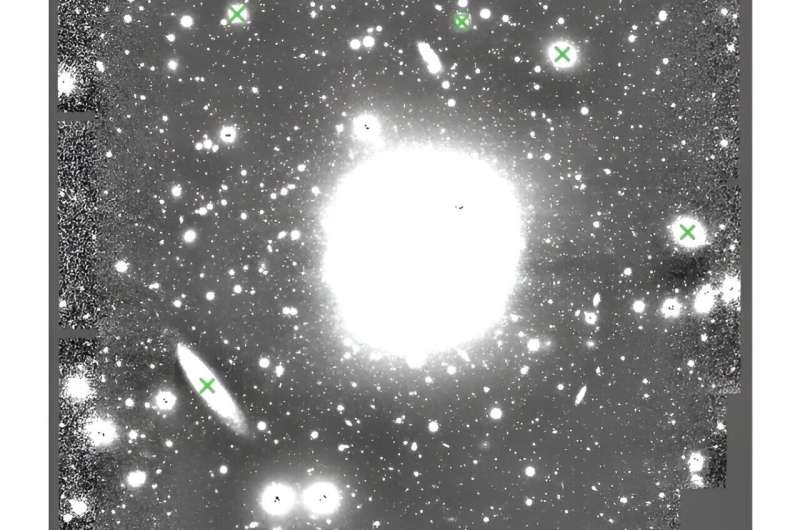June 20, 2024 report
This article has been reviewed according to Science X's editorial process and policies. Editors have highlighted the following attributes while ensuring the content's credibility:
fact-checked
preprint
trusted source
proofread
Galaxy NGC 4696 hosts a complex globular cluster system, observations find

Using the Magellan Telescopes in Chile, astronomers have performed photometric observations of a giant elliptical galaxy known as NGC 4696. The observations reveal that the galaxy has a complex globular cluster system. The finding was detailed in a paper published June 12 on the pre-print server arXiv.
NGC 4696 is an elliptical galaxy at a distance of about 145 million light years. It is the brightest galaxy of the Centaurus Cluster of galaxies, has an apparent size of 4.5 by 3.2 arcminutes, and a heliocentric velocity of approximately 2,958 km/s.
Previous observations of NGC 4696 have detected a filamentary structure crossing its central region and extending towards a nearby galaxy designated NGC 4696B. This suggests that NGC 4696 may have undergone a merger in the past or that the material was acquired by ram-pressure stripping of NGC 4696B.
Study of globular clusters (GCs) in and around NGC 4696 has the potential to provide more hints about its history, in particular its assembly and evolution. That is why a team of astronomers led by Sara Federle of the Andrés Bello National University in Chile has investigated NGC 4696, focusing mainly on its globular cluster system (GCS).
"We presented the analysis of the GCS of the giant elliptical NGC 4696. The measurements are based on deep Magellan 6.5m/MegaCam (g′, r′, i′) photometry," the researchers wrote in the paper.
First of all, Federle's team selected a sample of 3,973 globular cluster candidates in the field of NGC 4696. Afterward, by applying a two color selection, they identified a total of 3,818 GC candidates.
By analyzing the sample of identified GC candidates, the astronomers found that the GCS of NGC 4696 is disturbed, which suggests a complex evolution with other neighboring members of the Centaurus Cluster.
It turned out that the GCS of NGC 4696 has a bimodal color distribution with the blue peak at 0.763 mag and the red peak at 1.012 mag. The blue and red populations are divided at approximately 0.905 mag.
Furthermore, the study found that the color distribution in the GCS does not show the presence of a significant blue tilt—when blue peaks become redder for increasing cluster's luminosities. However, it exhibits a trend with the radius, where at small galactocentric distances, a unimodal distribution is preferable to a bimodal one, which points to the presence of an intermediate GC population.
The study also found that the GCS' metallicity distribution also showcases a bimodal trend and that the radial density profiles show different slopes for the blue and red populations. In addition, it appears that the azimuthal distributions for the total, red and blue populations of GC candidates are well fitted by an asymmetrical sinusoidal distribution, suggesting that interactions between NGC 4696 and its two nearby galaxies may have played a role in shaping its GCS.
"All these results point toward a complex GCS, strongly influenced by the interaction history of NGC 4696 with the other galaxies of the Centaurus cluster," the authors of the paper concluded.
More information: Federle et al, The turbulent life of NGC 4696 as told by its globular cluster system, arXiv (2024). DOI: 10.48550/arxiv.2406.08635
Journal information: arXiv
© 2024 Science X Network





















